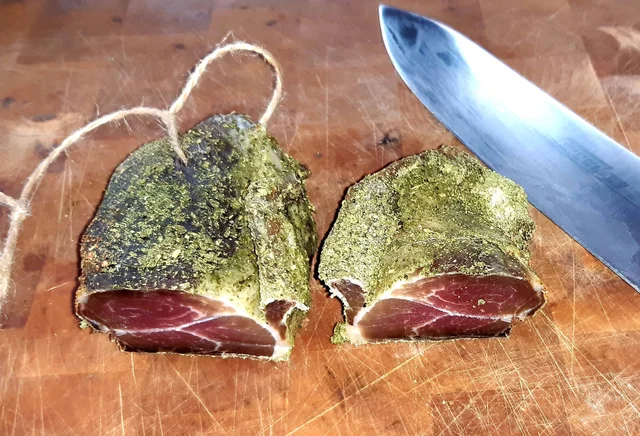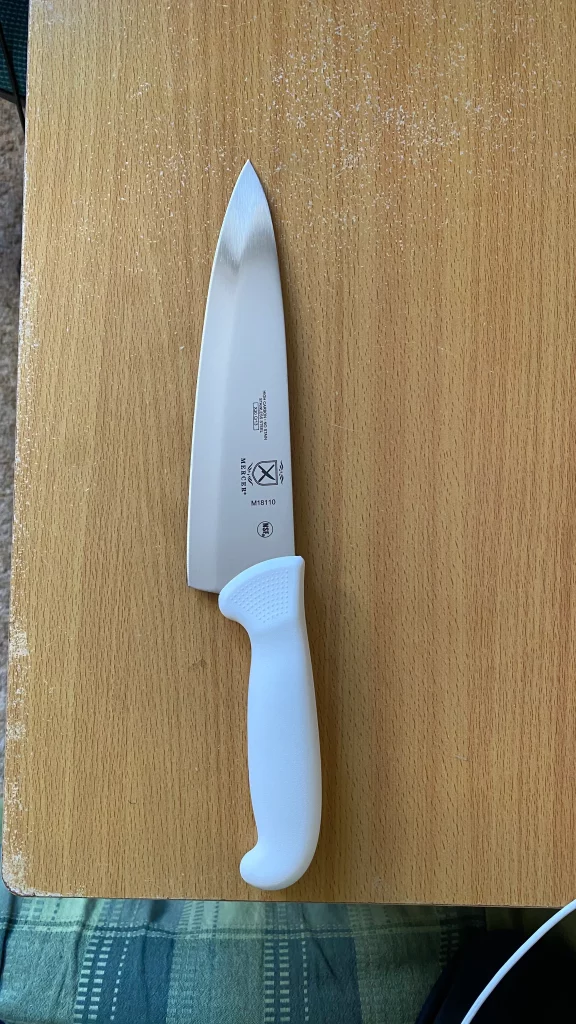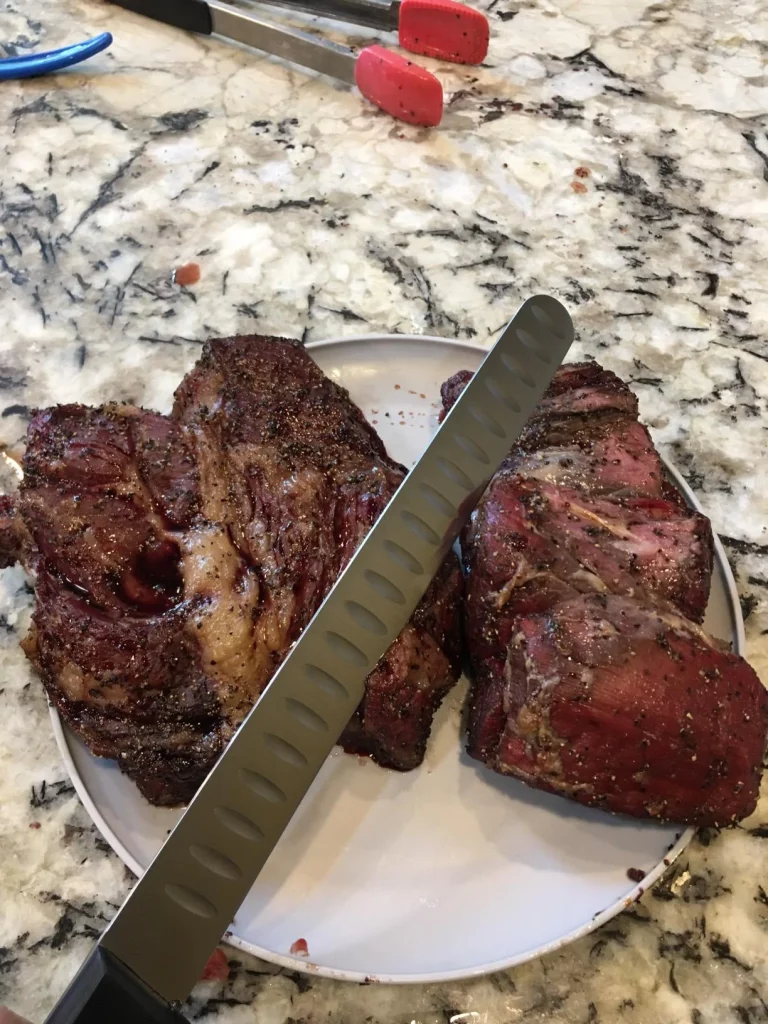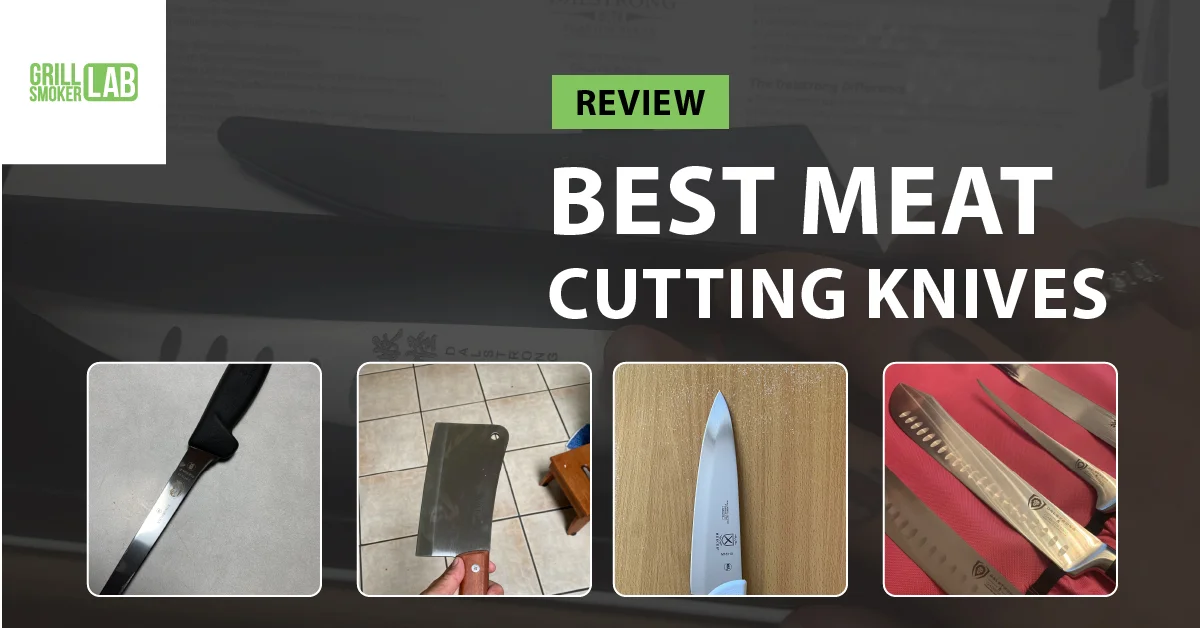The culinary world is vast, and when it comes to meat, having the right tools can transform the cooking experience. Butcher knives, meat cleavers, and carving knives, each with their unique build and specific purpose, are vital for chefs and home cooks alike to efficiently process, prep, and serve meat. From the reputable best butcher knives of 2023 to an affordable best knife under 30, there’s a broad spectrum available catering to various needs and budgets.
What is the best knife?
Identifying “the best” knife can be subjective and varies based on usage, preferences, and the meat type being handled. For instance, a boning knife is excellent for removing bones from chicken, while a prime rib knife or a carving knife might be more apt for slicing cooked meats. Chef knives often prove to be the best all-around knives – suitable for chopping, slicing, and dicing various ingredients, including meat.
Facts:
- A good-quality meat cleaver, like the best meat cleaver for the money, can cut through bone and is often used in butcher shops for breaking down larger cuts of meat.
- Boning knives have a narrow, flexible blade designed to navigate around bones and joints, offering precision in deboning tasks.
Highlight: An all-purpose knife like a chef’s knife or Santoku might be suitable for various kitchen tasks but having specialized knives, such as a butcher breaking knife or curved meat knife, could significantly elevate your meat preparation and processing skills.
Buyer’s Guide
Investing in good quality knives ensures not only seamless cooking preparation but also safety and efficiency in your culinary journey. Whether it’s a best kitchen knife under 100 or a professional butcher knife set, considering key factors during your purchase is crucial.
What to Look For In A Good Kitchen Knife
In the pursuit of the best knife on the market, considering blade material, edge retention, and ease of sharpening is vital. High-carbon stainless steel is a popular choice due to its sharpness and corrosion resistance. Remember, the sharpest knife for kitchen use will be as valuable as its ability to retain that sharpness over time.
Highlight: The best sharp knives are those that can maintain their edge with regular use, ensuring you’re not frequently reaching for a sharpener.
Balance
A well-balanced knife ensures stability and control during use. The weight distribution between the handle and the blade should be even, preventing undue strain and providing a more effortless cutting experience. Whether it’s a large chopping knife or a smaller paring knife, balance is key.
Fact: Balanced knives, especially in professional settings, can prevent hand fatigue and ensure precision in cuts, essential for both safety and culinary excellence.
Handle
The handle should offer comfort and a secure grip to prevent slipping, especially when working with wet ingredients. Materials like wood, plastic, and rubber can provide varying degrees of grip and comfort. Moreover, the butcher’s knife set you choose should have ergonomically designed handles to facilitate prolonged use without discomfort.
If you’re making a composite handle with multiple pieces, make sure you pin the pieces together as well as epoxy them. Using a mechanical connection in conjunction with the glue will ensure more strength. Also pay attention to the tang, make sure you fit your handle very snugly to the tang if you do not plan to glue the handle to the tang.
Highlight: Opt for handles that are riveted and have a full tang (meaning the metal of the blade extends through the handle) for stability and longevity.
Bolster
The bolster, found between the handle and the blade, adds stability and helps to prevent the hand from slipping onto the blade. In a professional butcher knife set, a well-crafted bolster can significantly impact the knife’s durability and user safety.
Highlight: A bolster is not only a safety feature but also a sign of a well-constructed, forged knife, indicating durability and quality craftsmanship.
Preassembled Knife Sets VS Building Your Own
Preassembled sets, like the best knife set under 200, often come with a range of knives suitable for various tasks. However, building your own set allows for customization, ensuring you have the best meat cleaver, butcher knife, and boning knife suited to your specific needs and preferences.
Fact: Building your own set may lead to a more significant initial investment but ensures each knife is hand-picked and tailored to your cooking style.
In summary, investing in a knife or a set should be based on a mix of your cooking style, reviews the best knife sets, the features of the knife, and, importantly, your budget. From best knives under 20 to top-tier professional sets, there’s something available for every chef, at every level.
Best Types of Knives for Cutting Meat
Adequately processed meat can enhance the culinary experience, offering you perfectly sliced steaks, precisely boned chicken, or meticulously chopped meat cuts. The type of knife used plays a pivotal role in determining the quality of the meat cut. Here we explore the essential types of knives to ace meat cutting and preparation.
Chef Knives
Chef knives, with their versatile design, make a crucial addition to any kitchen, aiding in chopping, slicing, and mincing. With typically 8 inches in length, they offer a balanced size to handle various meat cutting tasks adequately.
Highlight: Their curved blade allows for a rocking motion, which provides precise cuts and an efficient chopping mechanism.
Fact: Professional chefs often cite chef knives as their go-to tool due to their multi-faceted utility, demonstrating their essential nature in kitchens.
Butcher’s Knife
The butcher’s knife is characterized by a hefty build and a curved blade, optimized for breaking down larger meat cuts into smaller, manageable portions. It’s a must-have for those who often deal with larger meat pieces.
Highlight: The curved blade design facilitates a smooth, singular cutting motion, reducing the amount of pressure needed to cut through the meat.
Fact: Butcher knives were originally designed to break down whole animals, illustrating their capability in handling robust cutting tasks effectively.
Meat Cleaver
A meat cleaver is widely recognized by its broad, rectangular blade and is the ideal tool for tasks that require a bit more heft, such as chopping through bones or dense pieces of meat.
Highlight: The thickness and weight of the blade do the work, requiring less physical effort and ensuring clean cuts without splintering the bone.
Fact: In many traditional butcher shops, meat cleavers have been quintessential for decades to handle heavy-duty chopping, underlining their efficacy and reliability.
Boning Knife
Boning knives sport a thin, flexible blade, intended to remove bones from meat, poultry, and fish with finesse, ensuring minimal wastage of meat.
Highlight: Their flexibility allows for precise, close cuts around the bone, preserving the integrity of the meat.
Fact: The boning knife was notably employed in culinary schools as a specialized tool to teach students the art of deboning, symbolizing its pivotal role in meat preparation.
Slicing Knife
With a long, narrow blade, slicing knives are engineered for slicing through cooked meats with precision, ensuring thin, consistent, and intact slices.
Highlight: The slender and sharp blade minimizes resistance against the meat, maintaining the texture and preventing the meat fibers from tearing.
Fact: Slicing knives are often favored in carving stations and high-end culinary events due to their ability to produce elegant and clean slices, attesting to their precision and aesthetic utility.
Each knife serves its unique purpose, thereby enhancing the quality of your culinary creations, whether it be a perfectly boned chicken or a cleanly sliced roast. Investing in quality knives and understanding their specific applications in meat cutting can significantly elevate your cooking and preparation experience, paving the way for exquisite dishes. Remember, the best knife is the one that fulfills your specific culinary need with efficiency and ease.
FORGED VS STAMPED KNIVES
Choosing between forged and stamped knives can be pivotal, shaping your culinary experience and influencing the longevity and quality of the tool. Both have their own merits and drawbacks, with distinctions often reflecting in their performance, durability, and price.
Forged Knife
Forged knives are crafted with a meticulous process where a single piece of molten steel is cut and then pounded into the desired shape. This process usually makes the knife robust, providing a thicker, sturdier build with notably better balance and longevity.
Highlight: Forged knives often boast a bolster – a thick junction between the handle and the blade which enhances its stability and safety during use.
Fact: Historically, forged knives have been associated with premium quality and higher durability, often being the preferred choice of professional chefs for centuries.
Notable Aspects:
- Durability: Typically endure the test of time due to their solid construction.
- Balance: The manual craftsmanship usually ensures better balance, offering optimal control.
- Price: They tend to be more expensive due to the intensive manufacturing process.
Stamped Knife
In contrast, stamped knives are cut or “stamped” out of a sheet of steel. Post this, they are honed and heat-treated for strength. They are typically lighter and might lack the balance and heft of forged knives, but they are often more economically priced and can still offer commendable performance if well maintained.
Highlight: Stamped knives tend to be easier to maneuver due to their lightweight nature, making them an excellent option for fast-paced chopping and slicing tasks.
Fact: Stamped knives found their popularity surge in the 20th century, offering a more affordable alternative to the traditionally crafted forged knives, without significantly compromising on performance.
Notable Aspects:
- Weight: Generally lighter, providing ease of use for rapid, repetitive cutting.
- Flexibility: The thinner blade enables slightly more flexibility, useful for precise tasks like filleting.
- Affordability: Often come at a lower cost, making them accessible to a wider audience.
In summation, the choice between forged and stamped knives will often boil down to personal preference, budget, and specific culinary needs. A meticulously crafted forged knife might be the prime pick for a culinary professional seeking a balanced and durable tool, while a stamped knife may cater wonderfully to a home chef prioritizing budget and ease of handling. Each brings something unique to the table, embodying the essence of culinary versatility. It’s all about finding which type resonates with your cooking style and demands!
BEST MEAT CUTTING KNIVES

Discerning the right knife for meat cutting can elevate your culinary endeavors, ensuring you work with precision, ease, and efficacy. The meticulous selection of knives, especially when dealing with diverse meat cuts, not only enhances the chef’s workmanship but also safeguards the integrity of the ingredients.
BEST CHEF’S KNIVES
Chef’s knives, with their versatility and aptitude for various cutting tasks, stand as a staple in any culinary arsenal. Ideal for slicing, dicing, and chopping, a good chef’s knife manifests as an extension of the cook, offering both comfort and precision in every cut.
WÜSTHOF MODEL 4562-7/20

Wüsthof, a renowned German brand, brings forward its exemplary craftsmanship in the Model 4562-7/20 chef’s knife.
Highlight: Characterized by its precision-forged high-carbon stainless steel blade, it provides exemplary sharpness and durability.
Fact: Wüsthof has been a family-owned company for seven generations, harboring an impeccable legacy in crafting high-end culinary tools since 1814.
Notable Aspects:
- Blade Precision: With a 20 cm (approximately 8-inch) blade, it ensures precise and clean cuts, apt for various meat types.
- Handle: Ergonomically designed, it promotes effortless handling and maneuverability.
- Versatility: Designed to perform an array of tasks, from slicing steaks to finely chopping vegetables.
MERCER CULINARY ULTIMATE WHITE

Mercer Culinary Ultimate White, lauded for its accessibility and quality, offers a commendable choice for both novice cooks and seasoned chefs alike.
Highlight: The knife brings forth an ergonomic handle coupled with a razor-sharp, high-carbon, stain-free Japanese steel blade.
Fact: Mercer Culinary is often hailed for providing tools for the education sector, thereby being a prevalent choice among culinary students and apprentices.
Notable Aspects:
- Durability: The high-carbon Japanese steel promises longevity and consistent performance.
- Budget-Friendly: Offering a professional-grade tool without a hefty price tag.
- Accessibility: Widely available and recognized, making it an easy-to-find option for various culinary enthusiasts.
Embracing a chef’s knife that resonates with your culinary style and preferences will not only elevate your meat preparation endeavors but also amplify your overall cooking experience. The Wüsthof Model 4562-7/20 stands out for those seeking a premium, precision-engineered tool, while the Mercer Culinary Ultimate White emerges as a reliable, budget-friendly alternative. Exploring the nuances of each, from their blades to handles, will guide you towards a knife that not only slices but also truly cuts through to your culinary aspirations.
BEST BUTCHER KNIVES
Navigating through the myriad of meats, a butcher knife stands as a quintessential tool in ensuring cuts are done accurately, preserving the integrity and quality of the meat. Skilled butchery demands a knife that is resilient, sharp, and comfortable to work with, and here we explore two commendable options in the world of butcher knives.
DEXTER RUSSEL

Dexter Russel, an American classic, is widely embraced for its exemplary durability and quintessential designs in the culinary world.
Highlight: Dexter Russel’s butcher knives are renowned for their ease in handling and maintaining a consistent sharpness even through rigorous use.
Fact: Dexter Russel is the largest manufacturer of professional cutlery in the United States, boasting a history that stretches back to 1818.
Notable Aspects:
- Handle Comfort: With a design centered on ease and comfort, it mitigates hand fatigue even with extended use.
- Blade Quality: Crafted from high-carbon steel, it ensures a robust and sharp blade that can endure the demands of busy kitchens.
- Versatility: Dexter Russel butcher knives are available in various lengths and styles to cater to diverse butchering needs.
DALSTRONG

Dalstrong, a name synonymous with innovative craftsmanship and robust quality, offers a contemporary edge in butcher knives.
Highlight: The brand elevates traditional butcher knife designs with modern technologies and materials, offering a fusion of the classic and the contemporary.
Fact: Although relatively new to the knife-making world, Dalstrong has rapidly ascended in recognition due to its emphasis on innovation and quality since its inception in 2012.
Notable Aspects:
- Innovative Design: Dalstrong amalgamates traditional craftsmanship with modern-day technologies, yielding innovative designs and functionalities.
- Material Excellence: Utilizing high-carbon German steel, it assures a powerful, sharp, and resilient blade capable of intricate butchering.
- Aesthetic and Functional: Not only designed for functionality but also for aesthetic appeal, making it a visually striking addition to any culinary toolkit.
While Dexter Russel offers a classic and dependable butcher knife experience, Dalstrong brings forth a blend of tradition and innovation in its offerings. Both present notable merits in the realm of butchering, catering to various preferences and needs – be it the reliability of a longstanding manufacturer or the fresh perspective of a modern innovator. The impeccable artistry of butchering is not merely in the cuts but is significantly influenced by the tool in hand, making the choice of butcher knife pivotal.
SLICING KNIVES
The slicing knife, characterized by its long, narrow blade and often featuring a rounded or pointed tip, is a pivotal tool in the kitchen, engineered to gracefully navigate through larger cuts of meat, ensuring that juices and integrity are maintained. The precise, thin slices achieved with a top-tier slicing knife cannot be overstated. Let’s delve into two compelling options in the market.
VICTORINOX SWISS ARMY – 47645

Victorinox, a brand synonymous with precision and reliability, offers a line of professional knives that are a favorite among chefs and culinary professionals worldwide.
Highlight: The Victorinox Swiss Army – 47645 is hailed for its unmatched sharpness and ability to create impeccably clean and consistent slices.
Fact: Victorinox, established in 1884, is famed for crafting the Original Swiss Army Knife, and brings the same precision and quality to their kitchen knives.
Notable Aspects:
- Precision at its Best: The razor-sharp blade ensures minimal resistance through meats, providing precise, clean slices every time.
- Blade Integrity: High-carbon stainless steel ensures a blade that can resist corrosion and dulling, maintaining its sharpness even with frequent use.
- Ergonomic Design: The Fibrox Pro handle offers a comfortable, non-slip grip, making it safe and efficient for prolonged use.
MERCER CULINARY RENAISSANCE GRANTON EDGE

Mercer Culinary, a name often reverberated in culinary academies, fuses traditional German cutlery craftsmanship with modern technology, offering knives that are both resilient and cutting-edge.
Highlight: The Renaissance Granton Edge Slicing Knife is celebrated for its blend of traditional craftsmanship and innovative blade technology.
Fact: Mercer Culinary has become a prominent name in the culinary world, especially among culinary students, due to its emphasis on quality at an accessible price point.
Notable Aspects:
- Effortless Slicing: The Granton Edge design features hollow spaces on the blade that minimize friction and prevent food from sticking to the blade, enabling smooth slicing.
- Premium Materials: Crafted with high-carbon, no-stain German cutlery steel, the blade ensures robust performance and longevity.
- Balanced Handling: With a full tang that runs the entire length of the handle, the knife offers exceptional balance and user control.
Whether leaning towards the time-tested precision of Victorinox or embracing the innovative and accessible quality of Mercer Culinary, a proficient slicing knife stands as an indispensable asset in mastering the art of meat preparation. The merit in investing in a slicing knife that champions both sharpness and stability is mirrored in the perfection of each slice, safeguarding the flavor and texture integral to exceptional culinary creations.
BEST MEAT CLEAVERS
Mastering the art of meat preparation necessitates the use of a proficient meat cleaver. This robust, rectangular knife is engineered to disassemble meat with accuracy and strength, ensuring that each cut is clean, even, and maintains the integrity of the meat. Let’s explore two standout meat cleavers that have been praised by chefs and butchers alike.
HENCKELS MEAT CLEAVER

Henckels, a brand enriched with over 280 years of cutlery expertise, boasts a reputation for crafting knives that meld traditional craftsmanship with modern-day technology.
I really love my German knives. I highly recommend them. Besides the two there are other legendary German knifemaker especially in Solingen that make really great ones. You may want to have a look at them too.
It will mostly be used for chopping chicken in half. I also use a lot of cabbage, seems like a Classic Cleaver would be a lot better than the chef’s knife. I’m currently using for halving cabbage heads.
Highlight: Henckels’ Meat Cleaver is recognized for its formidable strength and durability, making it an optimal choice for processing large cuts of meat and poultry.
Fact: Henckels is one of the largest and oldest manufacturers of kitchen knives, scissors, cookware, and flatware, providing trustworthy quality since 1731.
Notable Aspects:
- Rugged Durability: The blade is constructed from high-quality stainless steel, ensuring enduring sharpness and corrosion resistance.
- Precision Cuts: The hefty blade ensures it can seamlessly navigate through meat and bone, providing clean, precise cuts.
- Ergonomic Handling: Featuring a traditional triple-rivet handle, it ensures comfort and stability during use, safeguarding against hand and wrist fatigue.
MEAT CLEAVER HEAVY DUTY KNIFE

This generically named, yet highly-efficient, Meat Cleaver Heavy Duty Knife is hailed for its uncompromising performance, particularly among amateur chefs and home cooks.
Highlight: This Meat Cleaver Heavy Duty Knife stands out for its extraordinary performance and affordability, making it accessible to a broad range of users.
Fact: Despite not being associated with a major brand, this meat cleaver has garnered commendable reviews and popularity on various online platforms due to its performance and value for money.
Notable Aspects:
- Sheer Power: With a heavy-duty, thick blade, it is designed to effortlessly cleave through meat, bone, and tough materials with ease.
- Rust-Resistant Blade: Crafted from stainless steel, it ensures sustained sharpness and a resilient blade that can withstand extensive use.
- Stable Grip: Featuring an ergonomic handle, the knife is designed to provide a stable, secure grip, ensuring accurate and safe usage during meat preparation.
Selecting a meat cleaver that harmonizes strength, stability, and precision is crucial in facilitating a seamless meat preparation experience. Whether opting for the longstanding quality of Henckels or the unyielding robustness and value of the Meat Cleaver Heavy Duty Knife, the assurance of clean, precise cuts ensures the flavors and textures of the meat are upheld, contributing significantly to the culinary result. Thus, investing in a reliable meat cleaver transcends mere utility, becoming an investment in enhancing the overall culinary experience.
BEST BONING KNIVES
Boning knives, with their narrow, sharp blades, are a pivotal tool for any culinary aficionado or professional, facilitating the meticulous separation of meat from bone, trimming away fat, and ensuring precision in every cut. Let’s delve into two remarkable models renowned in the culinary world.
VICTORINOX SWISS ARMY CUTLERY FIBROX PRO

Victorinox, the brand famously recognized for the Swiss Army Knife, extends its precision and craftsmanship into the culinary realm with its Swiss Army Cutlery Fibrox Pro boning knife.
Highlight: Victorinox is globally renowned for creating knives that exhibit precision, reliability, and extraordinary quality, which is embodied in the Fibrox Pro.
Fact: Victorinox ensures sustainable practices by utilizing 100% renewable energy in their production processes.
Notable Aspects:
- Precision-Engineered Blade: Crafted with high carbon stainless steel, it provides optimum sharpness, and resistance to wear and corrosion.
- Ergonomic Design: The Fibrox Pro handle is designed to provide a slip-resistant grip, enhancing safety and control during intricate cuts.
- Versatility: Not merely for boning, its flexible, razor-sharp blade also excels in filleting, preparing, and carving meats.
DALSTRONG BONING KNIFE

Dalstrong, a contemporary innovator in the cutlery industry, showcases its dedication to craftsmanship, technology, and design with their impeccable boning knife.
Highlight: Dalstrong combines innovative technology with traditional craftsmanship, creating knives that are not only functional but also aesthetically striking.
Fact: Dalstrong emphasizes the combination of high-quality materials with advanced technology, such as implementing high-carbon German steel in its blades.
Notable Aspects:
- Precision and Agility: The narrow, ultra-sharp blade provides excellent maneuverability, enabling precise separation of meat and bone.
- Durability: Engineered with high-carbon German steel, it assures durability, stain resistance, and sustained sharpness.
- Comfort and Stability: Featuring a laminated Pakkawood handle, it ensures a comfortable, secure grip while adding to its elegant aesthetic.
Both Victorinox and Dalstrong have successfully harmonized traditional craftsmanship with innovative technology to produce boning knives that guarantee precision, durability, and ergonomic ease. The Victorinox Swiss Army Cutlery Fibrox Pro excels in providing reliable, professional-grade tools for chefs and cooks at every level, while the Dalstrong Boning Knife unites function and form, presenting a tool that is both robust and beautifully crafted. Selecting a boning knife from either of these esteemed brands ensures an elevated culinary preparation experience, allowing the user to navigate through meat with unparalleled ease and accuracy.
Top Related Questions
Navigating through the vast world of kitchen knives, potential buyers often grapple with numerous questions regarding quality, maintenance, and value for money. Let’s tackle some of the top related questions and dissect them for detailed insights.
What is the best knife under $50?
Finding a quality knife under $50 can be a meticulous task given the myriad of options available.
Highlight: Affordable does not always equate to compromised quality.
Fact: Even esteemed brands like Victorinox offer models within this budget-friendly range, ensuring quality isn’t sacrificed for cost.
Notable Aspect:
- Quality and Budget: Seek knives with high-carbon stainless steel blades and ergonomic handles, which offer both durability and comfort.
How often should I sharpen my knife?
The frequency of knife sharpening is contingent on its usage and type.
Highlight: Regular honing can elongate the intervals between sharpenings.
Fact: Professional chefs typically sharpen their knives every few weeks, while home cooks may only need to do so a few times a year.
Notable Aspect:
- Maintaining Sharpness: Regular honing realigns the blade, preserving its edge and reducing the need for frequent sharpening.
What type of steel is a good quality for knives?
Steel quality is pivotal in determining a knife’s performance and longevity.
Highlight: High-carbon stainless steel is widely recognized for striking a balance between sharpness and durability.
Fact: VG-10 and SG-2 are high-end Japanese steels acclaimed for their exceptional edge retention and corrosion resistance.
Notable Aspect:
- Blade Integrity: Steels enriched with elements like vanadium or molybdenum often exhibit enhanced strength and wear resistance.
Is there a big difference between expensive and inexpensive knives?
Price can influence various facets of a knife, from materials to craftsmanship.
Highlight: An expensive knife often assures precision in craftsmanship, superior materials, and enhanced performance.
Fact: A well-maintained quality knife can last decades, potentially making it a more economical choice in the long run.
Notable Aspect:
- Long-Term Investment: While budget-friendly options exist, investing in a higher-priced knife often delivers in terms of longevity and performance.
Are ceramic knives good for chopping vegetables?
Ceramic knives are renowned for their incredible sharpness and lightweight nature.
Highlight: The exceptional sharpness of ceramic knives ensures precise and effortless vegetable chopping.
Fact: Ceramic blades retain their sharpness up to 10 times longer than typical steel blades but can be prone to chipping.
Notable Aspect:
- Usage Caution: While adept at slicing and chopping, ceramic knives should be used with care to avoid hard impacts that could damage the blade.
Do I need to take special care of my kitchen knives?
Preserving the integrity of your knives does necessitate certain care practices.
Highlight: Proper care extends a knife’s lifespan and maintains its performance.
Fact: Hand washing is generally recommended over dishwasher cleaning for knives, to preserve blade sharpness and handle integrity.
Notable Aspect:
- Storage: Adequate storage, like a knife block or magnetic strip, safeguards the blade and ensures safety in the kitchen.
Through examining these queries, one discerns that while the quest for the perfect knife may be intricate, understanding your culinary needs, budget, and desired materials ensures that your chosen blade will be a cut above the rest. Whether navigating through affordable options, deciphering steel types, or contemplating the merits of ceramic versus steel, arming oneself with knowledge ensures a keen edge in your culinary adventures.



![Char-Broil Digital Electric Smoker Review [W/ Video] 15 Read More About The Article Char-Broil Digital Electric Smoker Review [W/ Video]](https://grillsmokerlab.com/wp-content/uploads/2023/11/Char-Broil-Smoker-768x402.webp)